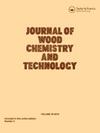Revisiting the mechanism of β-O-4 bond cleavage during acidolysis of lignin. Part 8: Comparison between phenolic and non-phenolic C6-C2-type model compounds
IF 1.7
4区 农林科学
Q2 MATERIALS SCIENCE, PAPER & WOOD
引用次数: 1
Abstract
Abstract A phenolic C6-C2-type lignin model compound with the β-O-4 bond, 1-(4-hydroxy-3-methoxyphenyl)-2-(2-methoxyphenoxy)ethanol (I), was acidolyzed in aqueous 82 vol% 1,4-dioxane containing 0.2 mol/L HBr, HCl, or H2SO4 at 85 °C. It was confirmed that about 15%, 15%, or 60%, respectively, of molecules of compound I do not primarily convert to the enol-ether compound, 1-(4-hydroxy-3-methoxyphenyl)-2-(2-methoxyphenoxy)ethene (II), but undergo direct β-O-4 bond cleavage. This contrasts with our previous result that most molecules of the corresponding non-phenolic compound primarily convert to the corresponding non-phenolic enol ether compound under the same conditions. The disappearance rates of compound I were markedly different between the acidolyses using three acids (HBr > HCl ≫ H2SO4), while those of compound II or the α-methyl-etherified derivative of compound I (III) were not largely different in its acidolysis under the same conditions. These results suggest that the marked difference in the acidolysis rates of compound I originates from the participation of Br− or Cl−. Acidolysis of the α-bromo-substituting derivative of compound I (IV) using HBr showed that Br− adds to the benzyl cation generated from compound I or III to afford compound IV, which consecutively undergoes the HBr elimination to convert to compound II, bypassing direct conversion of the benzyl cation to compound II and resulting in the fast acidolysis.木质素酸解过程中β-O-4键断裂机理的再探讨。第8部分:酚类和非酚类c6 - c2型模型化合物的比较
摘要:采用含0.2 mol/L HBr、HCl或H2SO4的82体积% 1,4-二氧六环水溶液,在85℃下对一种具有β-O-4键的酚醛c6 - c2型木质素模型化合物(1-(4-羟基-3-甲氧基苯基)-2-(2-甲氧基苯氧基)乙醇进行酸解。结果表明,化合物1中分别有15%、15%和60%的分子不是首先转化为烯醇醚化合物1-(4-羟基-3-甲氧基苯基)-2-(2-甲氧基苯氧基)乙烯(II),而是直接发生β-O-4键裂解。这与我们之前的结果相反,在相同的条件下,相应的非酚类化合物的大多数分子主要转化为相应的非酚类烯醇醚化合物。在三种酸(HBr > HCl ~ H2SO4)的酸解过程中,化合物I的消失率有显著差异,而在相同条件下,化合物II或化合物I的α-甲基醚化衍生物(III)的酸解消失率差异不大。这些结果表明,化合物I酸解速率的显著差异源于Br−或Cl−的参与。用HBr酸解化合物I (IV)的α-溴取代衍生物表明,由化合物I或III生成的苄基阳离子上加入Br−生成化合物IV,化合物IV依次经过HBr消去转化为化合物II,绕过苄基阳离子直接转化为化合物II,导致快速酸解。
本文章由计算机程序翻译,如有差异,请以英文原文为准。
求助全文
约1分钟内获得全文
求助全文
来源期刊

Journal of Wood Chemistry and Technology
工程技术-材料科学:纸与木材
CiteScore
3.70
自引率
20.00%
发文量
37
审稿时长
3 months
期刊介绍:
The Journal of Wood Chemistry and Technology (JWCT) is focused on the rapid publication of research advances in the chemistry of bio-based materials and products, including all aspects of wood-based polymers, chemicals, materials, and technology. JWCT provides an international forum for researchers and manufacturers working in wood-based biopolymers and chemicals, synthesis and characterization, as well as the chemistry of biomass conversion and utilization.
JWCT primarily publishes original research papers and communications, and occasionally invited review articles and special issues. Special issues must summarize and analyze state-of-the-art developments within the field of biomass chemistry, or be in tribute to the career of a distinguished researcher. If you wish to suggest a special issue for the Journal, please email the Editor-in-Chief a detailed proposal that includes the topic, a list of potential contributors, and a time-line.
 求助内容:
求助内容: 应助结果提醒方式:
应助结果提醒方式:


